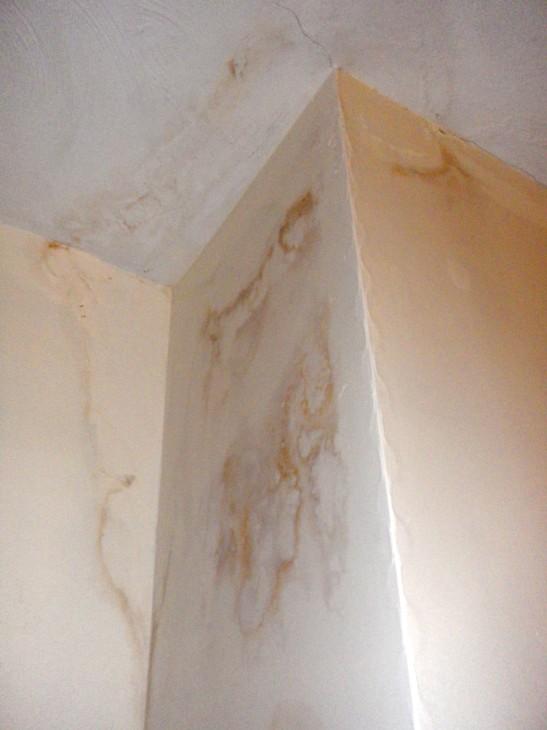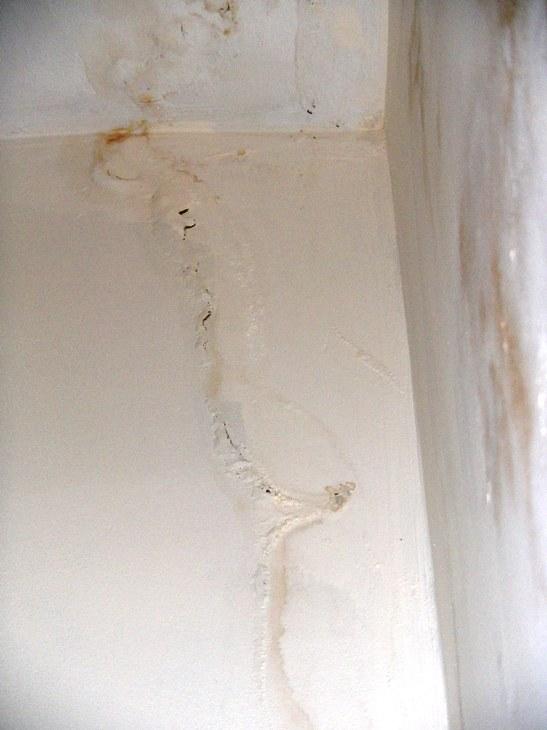Our house in (very wet, windy) Ayrshire, Scotland was built around 1965. It has the original roof tiles. The bricks appear porous externally but no obvious cracks in the area.
The chimney used to be for a coal fire, then a gas fire for many years. At end 2009 the gas fire developed a leak, so has been out of use since then.
In May 2010 the chimney stack was repaired, bricks sealed, painted with a waterproof coating and a new gas-fire cowl fitted. In Feb 2011 some damaged battens were replaced, tiles and pointing reset, additional bitumen added around lead apron.
In May this year (2011) damp patches started to appear on the chimney breast in the upstairs room, followed by a crack in the plaster of the wall next to the chimney, and now some damp spreading on the ceiling area. It seems to get worse after wet, windy weather (difficult to establish as it is seldom dry here!)
The left picture below shows the chimney breast and the wall; the picture on the right detail of the crack in the plaster.
A number of inspections have advised the roof tiles are old, but functioning as they should; felt is dry; the apron is sealed; no moss on tiles; no water appears to be seeping through. The narrow loft space is dry, as are the battens; no moisture can be felt under the loft insulation above the ceiling. Chimney breast in loft feels cold, but no moisture. Gutters are clear. Fascias appear sound.
We would be extremely grateful for any advice as we would prefer not to incur unnecessary expense (on the roof or elsewhere!) which may not solve the problem. Having read various other posts:
1) condensation: the fireplace isn't sealed below, so we would assume sufficient ventilation. The rooms themselves (both up and downstairs) are well-ventilated. Also, it started in summer?
2) would it be feasible for sufficient moisture to seep in through the gas cowl to cause this much damage?
3) could hydroscopic salts in the chimney breast (from the previous coal fire) attract this much moisture through porous wall bricks?
4) if it is seeping through the bricks, can water be forced upwards?
4) would it solve the problem to:
- firstly seal the external brick wall
- then re-connect the gas fire to heat and dry out the brick
- then use stain-stop/ filler?
We are planning to replace the leaking gas pipe and re-connect the gas fire, but don't want to do this until we know where the damp is coming from.
Thanks in advance for any advice!
The chimney used to be for a coal fire, then a gas fire for many years. At end 2009 the gas fire developed a leak, so has been out of use since then.
In May 2010 the chimney stack was repaired, bricks sealed, painted with a waterproof coating and a new gas-fire cowl fitted. In Feb 2011 some damaged battens were replaced, tiles and pointing reset, additional bitumen added around lead apron.
In May this year (2011) damp patches started to appear on the chimney breast in the upstairs room, followed by a crack in the plaster of the wall next to the chimney, and now some damp spreading on the ceiling area. It seems to get worse after wet, windy weather (difficult to establish as it is seldom dry here!)
The left picture below shows the chimney breast and the wall; the picture on the right detail of the crack in the plaster.
A number of inspections have advised the roof tiles are old, but functioning as they should; felt is dry; the apron is sealed; no moss on tiles; no water appears to be seeping through. The narrow loft space is dry, as are the battens; no moisture can be felt under the loft insulation above the ceiling. Chimney breast in loft feels cold, but no moisture. Gutters are clear. Fascias appear sound.
We would be extremely grateful for any advice as we would prefer not to incur unnecessary expense (on the roof or elsewhere!) which may not solve the problem. Having read various other posts:
1) condensation: the fireplace isn't sealed below, so we would assume sufficient ventilation. The rooms themselves (both up and downstairs) are well-ventilated. Also, it started in summer?
2) would it be feasible for sufficient moisture to seep in through the gas cowl to cause this much damage?
3) could hydroscopic salts in the chimney breast (from the previous coal fire) attract this much moisture through porous wall bricks?
4) if it is seeping through the bricks, can water be forced upwards?
4) would it solve the problem to:
- firstly seal the external brick wall
- then re-connect the gas fire to heat and dry out the brick
- then use stain-stop/ filler?
We are planning to replace the leaking gas pipe and re-connect the gas fire, but don't want to do this until we know where the damp is coming from.
Thanks in advance for any advice!



